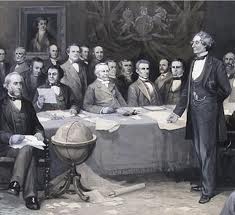Confederation Day
- July 1, 1867 – Canada first became a nation – BNA Act

- 4 British colonies joined to form the new Dominion of Canada
- Ontario, Quebec, Nova Scotia & New Brunswick (population = 3 million)
- John A. McDonald sworn in as Canada’s first prime minister
The Twentieth Century (1900-1913)
- Some colonies rejected confederation – i.e. Newfoundland (1949) & PEI (1912)
- 1867 – Strong provincial and regional differences in Canada
- Challenge of uniting regions that have different needs, geographies, peoples and economies
- Roots of regionalism (loyalty to a distinct region – i.e. Britain)
First Peoples, Early Settlement
- Aboriginals were the first inhabitants of Canada
- They lived as independent nations with their own governments, laws, traditions and culture
- French settlers in the early 1600s
- British (English, Scottish, Irish) settlers made up the majority of the population in the 1860s
The Twentieth Century (1900-1913)
- By 1900, Canada stretch from Nova Scotia to British Columbia to the Arctic Ocean
- Industries, cities, towns and farmlands in the west flourishing. It was said that the nineteenth century belonged to the U.S. as it had become a powerful nation and a land of opportunity for new immigrants
- 1904 – Prime Minister Wilfred Laurier said, “the twentieth century belonged to Canada”
Immigration Boom
- Between 1901-1911, Canada experienced the greatest wave of immigration in history
- Immigration – movement of people into a country from another
- Late 1800s – Canadian gov’t anxious to fill western territories (prairies) with settlers
- By 1890, still not enough settlers in the west
- 1896 – P.M. Wilfred Laurier’s Liberal gov’t – “open door” policy for immigrants
- Transcontinental Canadian Pacific Railway completed in 1885 – immigrants could ride the railways across the country to western prairies (free land offered; a fresh start)
- Europe becoming more industrialized – people leaving farms to work in factories = European countries needed to buy food from Canada (wheat, flour)
Choosing Canada
- Before 1901, most immigrants had come from Britain or the U.S.
- After 1901, Canada launches massive ad campaign in Britain, U.S. and Europe – “Come to Canada!”
- By 1890, American West was already taken up – Canada became “the last, best West!”
- Immigration from around the world = seeds of ethnic diversity in Canada
Contributions
- Immigrants helped Canada’s growing workforce
- In the West – Agricultural Boom – prosperous farms
- In the cities – immigrants worked in factories and construction
- In 1911 – 80% of the people in the West were born outside Canada
- Immigrants played important role in Canada’s economic prosperity & the development of the country
Discriminatory Policy
- British, European and American immigrants welcome, other groups were not
- Canada’s immigration policy in the early 1900s was discriminatory – Blacks, Italians, Asians, Arabs, Greeks, and Jews were not welcome
- Thought they would not make good farmers and would not easily assimilate (become absorbed into Canadian society)
- Believed immigrants should abandon their cultural traditions and conform to values of English-Canadian society
- In 1880s, many Chinese came to Canada to work on the Canadian pacific Railway – once the railway was complete, government discouraged Chinese immigrants
- Chinese immigrants required to pay a head tax – $50 in 1885 -> $100 in 1900 –> $500 in 1903
- 1914 – 5000 Sikhs on board a steamer ship called Komagata Maru – rejected from entering Vancouver
